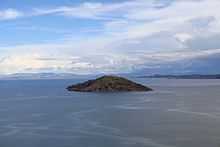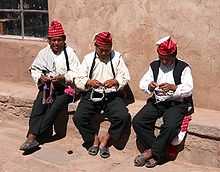Taquile Island
 Taquile from Amantaní Island | |
|
| |
| Geography | |
|---|---|
| Location | Lake Titicaca |
| Area | 5.72 km2 (2.21 sq mi) |
| Highest point | 4.050 |
| Country | |
|
Peru | |
| Demographics | |
| Population | about 1700 |
Taquile is an island on the Peruvian side of Lake Titicaca 45 km offshore from the city of Puno. About 2,200 people live on the island, which is 5.5 by 1.6 km in size (maximum measurements), with an area of 5.72 km2. The highest point of the island is 4050 meters above sea level and the main village is at 3950 m. The inhabitants, known as Taquileños, are southern Quechua speakers.
In 2005, "Taquile and Its Textile Art" were honored by being proclaimed "Masterpieces of the Oral and Intangible Heritage of Humanity" by UNESCO.

Taquileños are known for their fine handwoven textiles and clothing, which are regarded as among the highest-quality handicrafts in Peru. Knitting is exclusively performed by males, starting at age eight. The women exclusively make yarn and weave.
Taquileans are also known for having created an innovative, community-controlled tourism model, offering home stays, transportation, lodging for groups, cultural activities, local guides and restaurants. Ever since tourism started coming to Taquile in the seventies, the Taquileans slowly lost control over the mass day-tourism operated by non-Taquileans. The local Travel Agency Munay Taquile has been established to regain local control over tourism.
Taquileños run their society based on community collectivism and on the Inca moral code ama sua, ama llulla, ama qhilla, (Quechua for "do not steal, do not lie, do not be lazy"). The island is divided into six sectors or suyus for crop rotation purposes. The economy is based on fishing, terraced farming horticulture based on potato cultivation, and tourist-generated income from the approximately 40,000 tourists who visit each year.
The wildlife on Taquile includes rams, sheep, cows, guinea pigs, chickens. Dogs and cats are rare because the natives consider them delicacies for eating. If wanted, residents have to get permission from the authorities of the community.
Taquile offers a wide range of typical dishes. Breakfast consists of two pancakes with sugar or bread with eggs, with a cup of tea made from either Muña or Coca. For lunch, dishes are a vegetable soup, fish with rice, and a tomato and onion salad. For dinner, the Taquilean people serve vegetable soup with bread.
The majority of the inhabitants on Taquile are Catholic. They adapted this religion, harmonizing their ancient culture with the syncretic Christian culture. The mother earth (Patchamama), the principal Andean deity, directly controls harvesting, fertility. People offer the deity a number of payments each year, and three coca leaves prior to each activity or trip. God is present throughout the year in the festivities. The two Catholic churches are in Centre and Huayllano; a Seventh-day Adventist church is located in Huayrapata.
Taquile has a radio station and is equipped with generators. Islanders have elected to use solar panels to generate energy. Although chicken is eaten, poultry is not raised on the island due to problems with foxes.
Flowers and trees on the Island include Kolle, the tree used to roof the houses and for firewood, the Cantuta flower (the national flower of Peru), the Chukjo (used as detergent), and Muña (for stomach disease). A variety of flowers on the island are used as natural medicines, like Muna. The coca is brought from Puno and mainly comes from Cusco.
History
Indian Land, whose Quechua name some believe was Ink masters, was part of the Inca Empire and has a number of Peruvian ruins. The island was one of the last locations to capitulate to Spanish domination during the Spanish conquest of Peru. It was captured for Carlos V and eventually passed to Count Rodrigo of Taquila, after whom the island was named by the colonists. As the Spanish forbade traditional dress, the islanders adopted the Spanish peasant clothing.
They are known for maintaining that as traditional dress today. They combine this with finely made Andean-style garments and accessories (ponchos, belts, mantles, coca-leaf purses, and others).
Gallery
-

A festival on Taquile.
-

The annual Fiesta de Santiago.
-

Taquile, Puno, Perú. Mujer hilando.
-

Taquile - Peru - Lake Titicaca Children of Taquile.
-

The Arch leading to the main square of the island.
See also
- Iperu, tourist information and assistance
- Tourism in Peru
Bibliography
- Elayne Zorn, 2004. Weaving a Future: Tourism, Cloth and Culture on an Andean Island, Iowa City: University of Iowa Press. ISBN 0-87745-916-9
External links
-
 Media related to Taquile at Wikimedia Commons
Media related to Taquile at Wikimedia Commons - Munay Taquile - Community Based Travel Agency - owned by the people of the Taquile Island.
Coordinates: 15°46′38″S 69°41′03″W / 15.77722°S 69.68417°W